Guardians of the Lion City: Singapore Special Forces
Port City
The territory of Singapore at various times belonged to the empires of Srivijaya and Majapahit, Malacca, and the Malay sultanate of Johor. In 1613, the port city was literally wiped out by the Portuguese, who were at that time in a state of confrontation with the Malay states. After that, for two centuries, the island was practically empty - only a few fishing families lived there. Only at the beginning of the 19th century, the British colonialists noticed the island, who decided to create their own trading station here.
Founded by the British, the port of Singapore became part of the Straits Settlements - British ownership, from 1830 to 1867. part of the Bengal presidency of British India, and from 1867, it received the status of a separate British colony, directly subordinate to London. Straits Settlements united the British possessions on the Malay Peninsula - Malacca proper, Singapore, Penang and Dingings. Also to the crown colony of the Straits Settlements belonged Cocos Islands (Keeling) and Christmas. Singapore became the capital of the Straits Settlements as far back as 1832, and has since shown rapid growth in economic development. Since the island was not populous initially, the British colonial administration pursued an active policy of attracting immigrants from India and China. So the Chinese (mainly from the provinces of Fujian, Hainan and Guangdong) and the Indians (mostly Tamils from Tamil Nadu) made up a significant part of the population of Singapore.
The strategic role of Singapore obliged the British authorities to deploy significant military and naval forces here. In addition to British units, military units were also formed from among local residents. Thus, the Singapore Volunteer Corps was formed back in 1854, on the basis of which the Singapore Volunteer Artillery was created in 1888. As Singapore remained the most developed region of the British colony of the Straits Settlements, the national identity of the local Chinese and Indian and then the Malayan population grew rapidly. The first half of the twentieth century. in Singapore was accompanied by an increase in social and political tensions. It should be noted that although the port played an important role in maritime trade, most of the city’s population lived in abject poverty. A lot of Singaporeans of that time were opium addicts, and the opium trade, monopolized by the administration, until the second half of the 1920s. accounted for at least 50% of the Singapore budget revenues.
Like other colonies of Britain and other European powers in Southeast Asia, after the end of World War II, Singapore faced an upsurge in the national liberation movement, which was led by the Communist Party of Malaya. The main asset and supporters of the Communist Party were, above all, the Chinese living in Singapore and employed in various sectors of the economy. The positions of the communists after the war were especially strengthened because many anti-Japanese partisan detachments were created by the Communist Party of Malaya. This allowed the party to gain credibility among the local population, and for its paramilitary units to gain good combat experience. In neighboring Malaya, the Communists since the end of the 1940s. they fought — first against the colonial regime, and then against the authorities of sovereign Malaysia. Singapore had the opportunity to face a similar problem, especially since it was from 1963 to 1965. was a member of the Federation of Malaysia. By the way, the Singapore leadership pushed the growth of popularity of the communists and socialists towards unification with Malaysia.
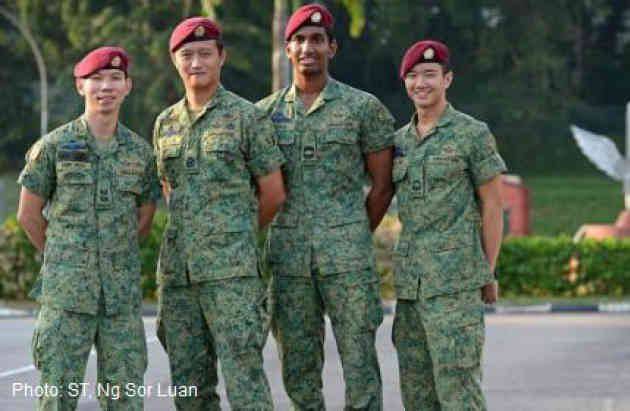
The tense political and social situation both in Singapore itself and in the countries neighboring Malaysia and Indonesia caused the creation of special units within the armed forces and police of this small Asian state. Despite the fact that Singapore is a small country, its armed forces comprise about 80 thousands of servicemen, including 72 thousands in the ground forces. In the case of mobilization, Singapore is able to put under a gun up to 300 thousands of reserve people. Each type of armed forces has its own special forces.
Army Special Forces - commando battalion
In the Army (Army of Singapore) there is the Formation of Commandos of the Armed Forces of Singapore (CDO FN), which is a subdivision of the battalion level (1-th commando battalion). The commando battalion specializes in operations in the rear of the enemy in order to destroy specific targets and conduct reconnaissance operations. History CDO FN began in 1967, when the command of the Singapore armed forces instructed Major Clarence Tan and Major James Chia to select candidates from among the Singapore Army soldiers to form a commando unit of the Singapore armed forces. 1 December 1969 is considered the official date for the formation of the battalion commandos of the Singapore armed forces.
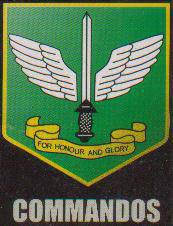 The direct control of the unit was carried out by the Singapore Ministry of Defense, and the captain Tem Chi He was appointed commander. The first group of commandos included 20 military. In 1970, recruitment to the unit was continued. 3 May 1971 was introduced the distinctive badge of the battalion - red takes as a headdress. 16 July 1971, the unit was renamed the 1-th battalion commandos, and in 1973, in its composition was formed the second company under the command of captain Gvi Peng Hoon and the officers of the company warrant officer 2 class Khiong Kian Khun.
The direct control of the unit was carried out by the Singapore Ministry of Defense, and the captain Tem Chi He was appointed commander. The first group of commandos included 20 military. In 1970, recruitment to the unit was continued. 3 May 1971 was introduced the distinctive badge of the battalion - red takes as a headdress. 16 July 1971, the unit was renamed the 1-th battalion commandos, and in 1973, in its composition was formed the second company under the command of captain Gvi Peng Hoon and the officers of the company warrant officer 2 class Khiong Kian Khun. From July 1973 to January 1975 Third, fourth and fifth companies were formed. The first commander of the third company was Captain Boon Hon Lin, the fourth company - Captain Lim Xiang Tong, and the fifth company - Lieutenant Dominic Teo. In April, the command battalion 1975 was reorganized and reassigned to the command of the 3 division. In 1977, along with two guards battalions, the commandos reassigned the headquarters of the 7 Infantry Brigade, and in 1980, the ground forces headquarters itself. 1 October 1980 was opened commando training school. At the same time, the unit received a new emblem - a winged dagger with the motto "For honor and glory." The winged dagger on the emblem denotes the elite status of commandos as a parachute unit. Since December, 1986 dagger has been awarded to commandos who have served in the unit for at least two years, while the red beret is awarded to all recruits who have successfully completed the preparatory course. Red beret special forces dress in parades and ceremonies that happen quite often - Army special forces perform the functions of a guard of honor at the meeting of foreign guests and participate in festive parades of the Singapore army.
As in all countries of the world, in Singapore, the recruitment of army special forces is carried out on the basis of the selection of the "best of the best." Before enrolling in a special unit, candidates undergo a medical examination and show their physical fitness. Candidates are then subjected to more sophisticated testing that evaluates intellectual capabilities. Successful testing allows the candidate to proceed to the next step - to be enrolled in one of the mouths of the commando battalion to complete the initial training course in the specialty.
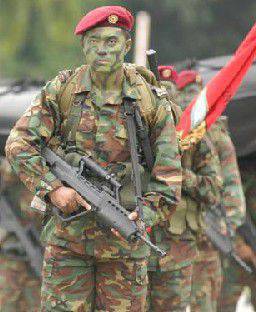 The main personnel resource of army special forces are reservists who are regularly involved in retraining and advanced training in commando schools. Training for saboteurs is carried out on a separate profile, after completing the basic training course at the company level in the Hendon camp. The training of special forces is carried out at the Commando School. The basic training course includes, first of all, a very tough physical training with a focus on the development of hand-to-hand combat, making marches and throws with full display. The special forces are required to have a much higher level of physical training compared to the military personnel of other units of the Singapore Army. At the stage of basic training, there is a dropout of candidates who are unable for certain reasons to carry out the duties assigned to the special forces.
The main personnel resource of army special forces are reservists who are regularly involved in retraining and advanced training in commando schools. Training for saboteurs is carried out on a separate profile, after completing the basic training course at the company level in the Hendon camp. The training of special forces is carried out at the Commando School. The basic training course includes, first of all, a very tough physical training with a focus on the development of hand-to-hand combat, making marches and throws with full display. The special forces are required to have a much higher level of physical training compared to the military personnel of other units of the Singapore Army. At the stage of basic training, there is a dropout of candidates who are unable for certain reasons to carry out the duties assigned to the special forces.After completing the basic training, candidates begin to study in specific specialties that are in demand in the special forces. There are several major specialties in the battalion. This is a signalman, medic, armament specialist, small boat operator, sniper, demolition man. Also, all recruits must undergo an airborne training course and make five jumps, including two jumps - at night. After successfully completing the course, they are given the right to wear a parachutist mark.
In addition to the Singapore training camp, special forces recruits can also be sent for training in the jungle in the territory of the Sultanate of Brunei, with which Singapore cooperates in the field of defense and security. The duration of all stages of the training course is a whole year, after which the special forces make the 72-kilometer march, and then the parade is given a solemn presentation of red berets. The most successful commandos may receive additional training in advanced training courses at the Commando School. They master the specialties of the commanders of the commando departments, airborne training instructors, physical training instructors, and small boat operators. In addition to the Brunei Armed Forces, Singapore Special Forces maintains relations with the 1 Battalion of the Royal New Zealand Infantry Regiment. 14 March 1982 was held the first joint parade of the two divisions, and in 1993, the practice of regular exchange of officers began to improve the skills of the commanders of the special forces of both countries.
Throughout its history, Singapore Army Special Forces participated in a number of operations in the country. The most famous of them occurred in the 1970-ies. Thus, in 1974, the special forces participated in ensuring the security of the release of hostages at the Shell oil refinery complex, in 1975 they stormed the ships that held the Vietnamese refugees in the territorial waters of Singapore. In 1991, in Singapore’s Changi airport, commandos freed the hostages and killed four terrorists within five minutes. For this operation, the commando battalion was awarded a government award. Currently, the battalion commando of the Singapore army is commanded by Colonel Simon Lim.
The growth of international terrorism has forced the Singaporean authorities to be more attentive to the problem of ensuring security from terrorist threats. In 1985, the Special Operations Force (The Special Operations Force (SOF)) was created. This unit is even more elite compared to the commando battalion. The SOF includes weapons specialists, signalers, snipers, demolition men and boatmen. Special operations forces specialize in countering terrorism, freeing hostages and special intelligence.
The training of special forces is carried out using the experience of American special forces, French naval commandos, Australian and New Zealand special aviation services. The general SOF fighter training course lasts four years. During this time, the selected candidate, if he is not eliminated at any stage of training, turns into a professional special forces. The recruitment of candidates is carried out in all divisions of the Singapore Armed Forces. Like army commandos, Special Operations Forces soldiers, upon successful completion of the training course, receive a red commando beret and are endowed with all the rights and privileges of army special forces.
Singapore "seals"
Another elite special unit of the Singaporean armed forces, and more precisely - the Singaporean Republican fleetThis is the Marine Diving Squad (NDU). His competence includes rescue operations, underwater mining and demining, and special intelligence. The traditions of this elite unit go back to the colonial era - it directly inherits the combat training methods of similar units of the British fleet. After the withdrawal of the Royal Navy from the territory of Singapore, a scuba diving center of the armed forces of Singapore was created, which in 1975 was transformed into a naval scuba diving group. At the first stage of the existence of underwater swimmers, their tasks included the implementation of inspections of ship hulls. In the mid-1980s underwater swimmers began to be used to support ships in the port of Singapore, the disposal of explosive ordnance.
Like other special forces, combat swimmers have increased requirements for the training of selected candidates. Every year, thousands of military personnel apply for admission to this unit. First of all, they undergo a medical examination and a test of physical fitness. Excellent vision is the most important requirement for future combat swimmers, so there can be no people in glasses in a unit.
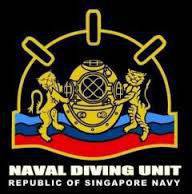 Also, candidates must feel confident in the water, in their psychological qualities to be able to serve in the special forces.
Also, candidates must feel confident in the water, in their psychological qualities to be able to serve in the special forces. At the diving school, candidates for special forces take a nine-month training course, which includes a basic military training course, a land combat training course and a combat swimming course. As the courses become more complex, the screening of candidates also occurs - many of them do not withstand the intense rhythms of training. The basic course of study includes navigation, the detection of explosive devices, the neutralization of explosive devices, and special land operations.
The final stage of preparation is called “hell week”. These are five-day exercises, during which the fighters are practically deprived of sleep and rest, experiencing extreme physical and mental stress. At this point, among the cadets, only 50% of those enrolled in the Diving School remain. After a nine-month basic course, recruits are sent to either the underwater demolition group or the diving support team. The group of underwater demolition men is the main part of the marine special forces. They are being trained abroad - in the United States of America and other countries where they improve their skills in the maritime subversive business. In addition, combat training is conducted on the bases of the SAS of Great Britain
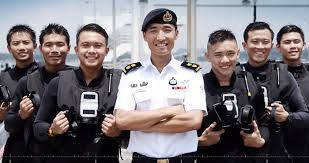 In 2009, on the basis of the Singapore Special Operations Force and the Singapore Navy combat swimmers, it was decided to create the Special Purpose Operations Forces (SOTF), which is a combined group that includes the army commandos and fleet combat swimmers. The competence of this special unit includes the fight against all manifestations of terrorism on land, in water and in the air, the release of hostages. Anti-terrorist operations are the main activity of this special unit.
In 2009, on the basis of the Singapore Special Operations Force and the Singapore Navy combat swimmers, it was decided to create the Special Purpose Operations Forces (SOTF), which is a combined group that includes the army commandos and fleet combat swimmers. The competence of this special unit includes the fight against all manifestations of terrorism on land, in water and in the air, the release of hostages. Anti-terrorist operations are the main activity of this special unit. Singapore Police Special Forces
In such a huge city as Singapore inevitably arises, and very seriously, the problem of combating crime. From the middle of the 19th century, Chinese mafia communities of triads operated in Singapore, and drug trafficking flourished. Currently, in this small country there are very strict laws aimed at the most effective maintenance of public order. But sometimes there are failures - first of all, it concerns the mass manifestations of popular discontent, as well as the terrorist activities of groups from neighboring countries. Not in all cases, the fight against them can be carried out by army special forces - the participation of experienced law enforcement officers is also required. Therefore, as part of the Singapore police forces have long been their own special forces.
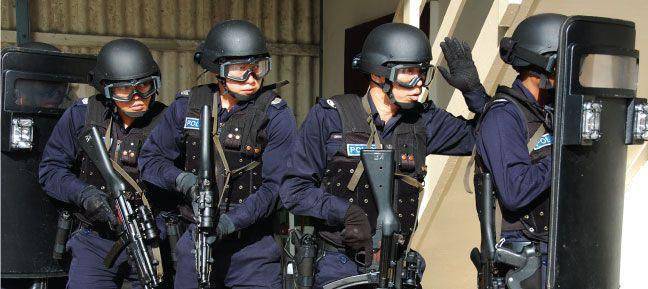
The most well-known police special forces - the Special Operations Command (SOC). In fact, this is the Singaporean counterpart of the Russian OMON - a unit focused on curbing riots and protecting public order in emergency situations. The history of the unit dates back to the colonial era - in 1952, a team of 60 policemen was created, who were given the task of deterring protesters during mass protests and riots. The training was led by Colonel F. Fairburn, formerly Assistant Commissioner of the Shanghai Municipal Police. He directly and selected those who wish to serve in the unit. In 1953, the number of units increased to 150 employees.
However, in its modern form SOC appeared 10 September 1992 g. The command structure includes the Tactical Police Unit (PTU), whose immediate tasks are disaster management and countering riots. Also, employees of the unit provide security during the detention of dangerous criminals, are used to carry patrol and inspection service in Singapore. In essence, this unit is the historical basis of the Singapore Special Operations Command. The unit’s officers used to wear blue berets, blue uniforms, and black combat boots. However, in 2005, the uniform of the police special forces was changed - they put on high boots on garters, made the blue uniform darker, and changed the color of the beret to red (the last step was made for purely pragmatic reasons - the staff’s red are less visible during the collisions at mass demonstrations).
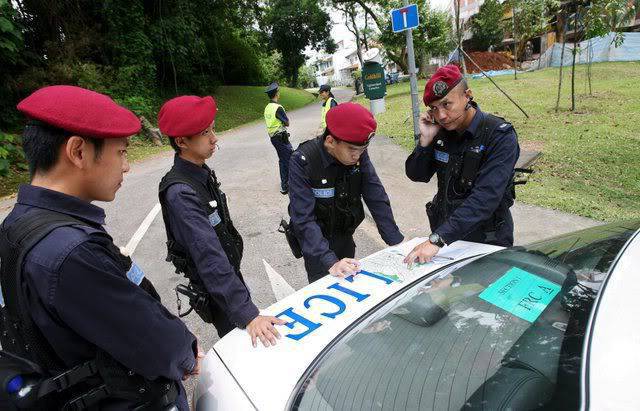
In 2005, a police special unit was also formed to ensure the safety of railway stations and trains. In 2009, this unit was isolated from the SOC and renamed as an independent Public Security Command for Transport. The tasks of this unit include the protection of order at the stations of the Singapore Metro. Candidates for service are selected from among officers of other police units, as well as military personnel of the national reserve. The guards in the subway differed from other policemen in blue berets, which were then replaced with light gray ones - as a sign of the independence of the unit. Command personnel carry patrol and security services in the metro, and their activities extend to bus stations and transport terminals in Singapore.
“Special Tactics and Rescue” (STAR) is an elite unit of the Singapore police special forces, faithful to its motto “Vigilance. Valor. Victory". The history of this special unit began in the late 1970's. Initially, a special unit was created from a number of volunteer officers recruited from the Tactical Police Unit. The official date for the creation of the group in its present form is 1 November 1993. Before 11 September 2001, the group participated in neutralizing armed and dangerous criminals, preventing gunfights and hostage-taking in the city, guarding government officials, foreign guests and escorting prisoners. 11 September Events 2001 forced the Singapore police leadership to focus the group’s efforts on anti-terrorism duties. Only active police officers are selected for the group. Candidates undergo physical, medical and psychological selection, after which two-week testing and a six-month training course begin. In training, the team interacts with the police special forces of Israel, Germany and Australia.
The Special Operations Command also includes another small, but very interesting special unit. This is a Canine Police Unit (PDU). It specializes in the training of police dogs, the detection of explosives and drugs, the protection of important objects and public order, the fight against criminal crime, acting in close liaison with other police units of Singapore. For the first time, the dogs were used by the British authorities in Singapore back in 1911, when the police officers purchased an Airedale Terrier from a British officer to search for escaped prisoners in a local prison. However, after the death of a dog, the development of dog service in the Singapore police stopped temporarily and only in 1950-s, taking into account the positive experience of using police dogs in the UK, Singapore also began preparations for creating its own police dog service. At the High School of Police a prototype of dog training was created with four German shepherd dogs. Currently, 250 dogs are serving in the Canine Police Unit.
Gurkha in Singapore service
In the colonial era, the history of a very bright police unit goes, without which it is impossible to imagine Singapore. This is the Gurkha contingent. The legendary Gurkhas, the Nepalese Highlanders, who from the beginning of the 19th century began to serve in special units of the British army, now, after the collapse of the colonial British Empire, continue to carry military and police service in Britain itself, in India and in some other former British colonies, Including in Singapore. The history of the Gurkha contingent began on 9 on April 1949, after the independence of India from the British Empire was declared, after which the Gurkha battalions were divided between the Indian and British armies. Those units that remained in the British army were transferred to countries that still remained in the status of the colonies of Great Britain.
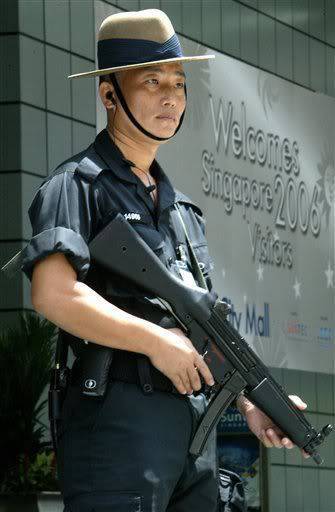 In particular, the Gurkha units were redeployed to Malaya and Singapore, where they had to take part in the suppression of the communist insurgency in the jungles of Malacca. In 1964, the Gurkha participated in the suppression of mass clashes between Muslims - Malays and Chinese on the birthday of the Prophet Muhammad. An important role in choosing Gurkha as a military-police unit of Singapore was played by their neutrality in the domestic policy of the country, since the Gurkha were not local residents and, accordingly, did not sympathize with any of the ethnic groups living in Singapore. Therefore, their use in suppressing riots seemed the most justified and effective. Therefore, over the 66 years of deployment in Singapore of the Gurkha contingent, its number grew from 142 employees in 1949 to 2000 employees in 2003.
In particular, the Gurkha units were redeployed to Malaya and Singapore, where they had to take part in the suppression of the communist insurgency in the jungles of Malacca. In 1964, the Gurkha participated in the suppression of mass clashes between Muslims - Malays and Chinese on the birthday of the Prophet Muhammad. An important role in choosing Gurkha as a military-police unit of Singapore was played by their neutrality in the domestic policy of the country, since the Gurkha were not local residents and, accordingly, did not sympathize with any of the ethnic groups living in Singapore. Therefore, their use in suppressing riots seemed the most justified and effective. Therefore, over the 66 years of deployment in Singapore of the Gurkha contingent, its number grew from 142 employees in 1949 to 2000 employees in 2003. Candidates for the service are recruited in Nepal at the British Gurkha camp in Pokhara. A candidate for service in a Gurkha unit must be aged in the range from 17,5 to 21, not lower than 160, see height and not less than 50 kg. weight. Also, Gurkha is expected to have minimal education and at least basic knowledge of English. The selection process takes 17 days and includes a set of tests in English and mathematics, interviews, medical examinations and physical fitness tests. After selection, recruits are transferred to Singapore, where a permanent training camp of the Gurkha contingent in Mount Vernon operates. Here, for ten months, recruits receive military training. For training in the jungle, including against the rebels, Gurkha, under a special agreement with the royal police of the Brunei Sultanate, are sent to training in the jungles of Brunei.
During the British colonial administration of Singapore, the Gurhke contingent was commanded by a British officer seconded from the British army. The Nepalese officers occupy the posts of inspectors of the Gurkha contingent. The unit has its own orchestra with drums and bagpipes. For many decades, the structure of the Gurkha contingent remained unchanged. The Gurkha contingent has the following special ranks for its officers: constable (private police), junior corporal, corporal, sergeant, staff sergeant, senior sergeant, station inspector, inspector, chief inspector, assistant superintendent, vice superintendent, superintendent, vice assistant Commissioner, Assistant Commissioner.
Thus, if in the junior commanding structure in the Gurkha contingent army ranks remain, then in the middle and senior commanding staff (here we take the analogy with the Russian special ranks of the Ministry of Internal Affairs, since there is no such division in Singapore) all the ranks are purely policemen. Singapore Gurkhas wear a standard dark blue uniform for the policemen of this country, but they are distinguished by traditional Gurkha hats, which make it easy to recognize the Gurkha employees. Khaki hats are worn during guard duty and parades; the blue beret is used in the everyday form of the Gurkha contingent.
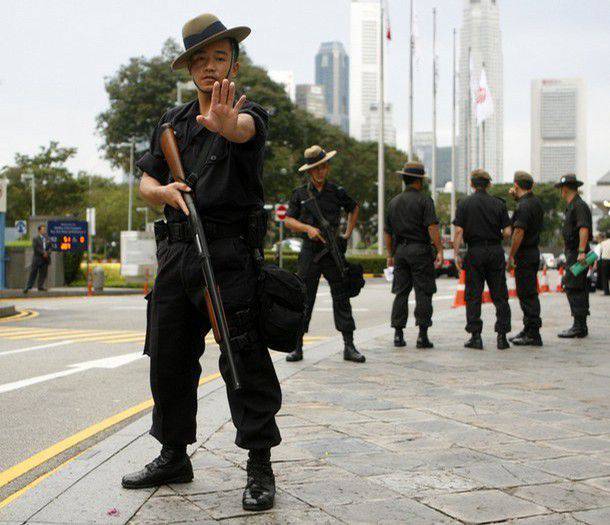
Employees of the Gurkha contingent perform tasks to provide VIP-persons, first of all - high-ranking officials of the Singaporean government. After the September 11 attack, 2001, the Singapore authorities reinforced the anti-terrorist orientation of the Gurkha contingent units, which had a corresponding effect on the preparation of the Gurkhas and the spectrum of their functions. Gurkha perform tasks for the protection of strategic sites, polling stations during elections, catching runaway prisoners, ensuring public order at public events. Also, Gurkha contingent specialists participate in training other police and military personnel, especially in the field of physical training. In 2000, the Gurkha unit was part of the Singapore police contingent of the United Nations Transitional Administration in East Timor. In addition, the Gurkha were part of 30 police instructors sent to Iraq to train local police personnel. 8 December 2013 The Gurkha contingent participated in the suppression of riots.
Despite the fact that the Gurkha have been serving for the maintenance of order in Singapore for more than half a century, they are guest workers by status. Singaporean authorities do not allow Gurkha contingent employees to marry with local residents. But Gurkha can bring to the temporary residence of their Nepalese wives and children. They live in the contingent camp at Mount Vernon. It is an autonomous Gurkha village, which practically does not interact with the outside world. Gurkha reside there with their families. Gurkha children study at the secondary school closest to the camp. To achieve 21 year, they are obliged to leave the territory of Singapore. Nevertheless, even despite the existence of prohibitions that are discriminatory from the point of view of a modern person, the number of people willing to join the Gurkha units of the British army or the Singapore police does not decrease. Every year, before 20, 000 man applies to the qualifying station, but only 370 lucky ones manage to go to the service in elite units. But those who are lucky enough to qualify can count on a stable monetary allowance, numerous benefits, education for children.
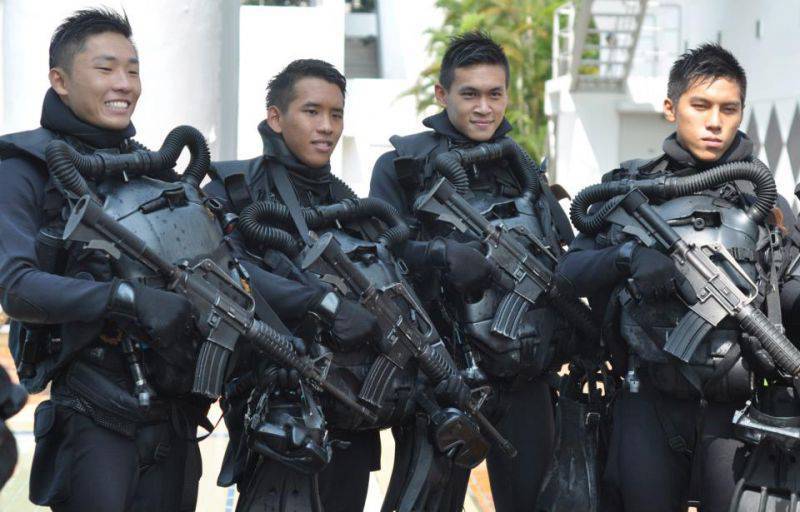
Information